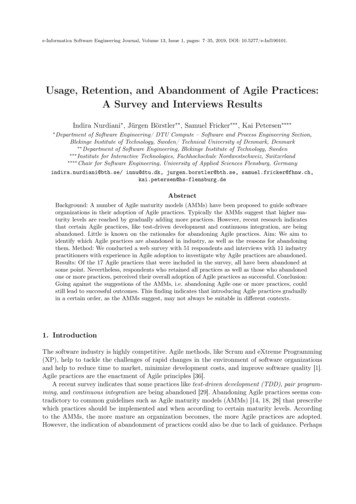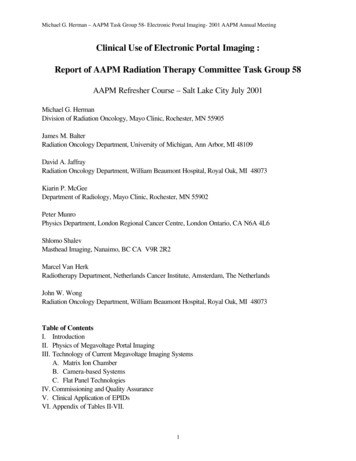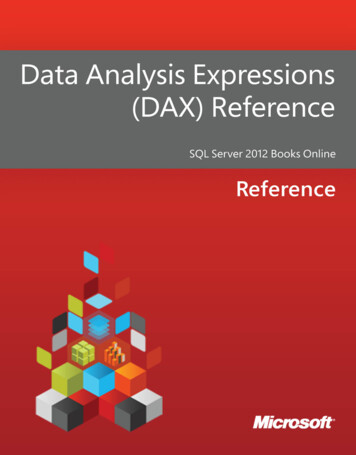
Transcription
REPORTLav FöreningService design: lichen study, farm innovation andenterprise framework for re-active rural culturallandscapeName of author: Huanyu LiName of degree: Master of Fine ArtProgram: Design, Master ProgramInstitution: Faculty of Arts and HumanitiesUniversity: Linnaeus UniversityYear: 2016Supervisor: Petra Lilja, Fredrik Sandberg, Johan VajdeOpponent: Sara Hyltén-Cavallius, Ola StåhlExaminer: Lars DafnäsDate of examination: 2016-05-17
AbstractI start this project as my master degree project which is the lastassignment during my graduate education in Sweden. I own thebachelor degree in industrial design which is the beginning I ponderin a designer’s way. With the accumulation of my knowledge andstudy, I am willing to attempt different design fields in sustainableperspective, like product design, furniture design, exhibition designand service design. The working and study experiences providevaluable resources for me to recognize self. And the environment inSwedish society also is a school to acquire knowledge and know theworld. The project, Lav Förening, was born in these contexts.The main study fields: Rural depopulation was addressed as a globalissues in economical, ecological, socio-political and cultural contextsin sustainability perspectives. The rural economic stagnation can berestore by government policy support. However, the disappearance ofcultural landscape would cause irreversible loss. With case studies andfieldwork in Varshult, I define my study field in service designinvolving lichen study, farm innovation and enterprise framework for
re-active rural cultural landscape. It is a proposal, through figuring outlocal renewable resource (lichen) and integrating stakeholders’framework, to create an attractive community for rural part-timeresidents and young active citizens to participate. In order to completethe concept, there are six fields need to be study: depopulation andsustainable rural development, cultural landscape, lichen and essentialoil, community agriculture and Boda Glass Factory.The major findings of my study:The service in this project is humancentered. Through studying Maslow's hierarchy of needs, I analyze theneeds of my target group. For the target group in Lav Förening, ruralpart-time residents and young active citizens, they have a good livingconditions and enough spare time for their interests and pursuits. Forthe organizers and land owners, we are concerning the socialphenomenon, rural depopulation, and we devote ourselves to figureout the opportunities to solve the problems and keep the rural culturallandscape alive. We pursue a higher level of psychological, belonging,esteem and self-actualization needs. There are six programs on lichenjourney based on the needs study: Varshult visiting & lichen planting,
bottles making, lichen collection essential oil extraction & tincturemaking, handmade workshop and market & exhibition. The proposalwill be presented with visualizations and evidences.The Lav Förening service proposal need to be refined continually. Itshows an opportunity to oppose rural depopulation in design field. Itis a practice for me to analyze a complicated framework and presentit. The design process and report have recorded the development andexploration on my design study.Key works: Service design, Rural depopulation, Sustainabledevelopment, Cultural landscape, Lichen community
Contents1.2.3.Introduction . 11.1Brief project description . 31.2Background and motivation. 51.3Aims and purposes . 81.4Delineation of field of study . 101.4.1Depopulation and sustainable rural development 101.4.2Cultural landscape. 141.4.3Lichen and essential oil . 161.4.4Community supported agriculture . 211.4.5Boda Glass Factory . 261.5Delineation of project . 281.6Formulation of question . 28Theory . 302.1Sustainable rural development . 312.2Service design . 322.2.14D service design principle . 342.2.2D4S map . 372.2.3Service design tools and methods . 38Context. 393.1Ecological, economical, socio-political and cultural contexts393.2Contemporary works . 403.2.1Sustainable rural development oppose depopulationcase study . 403.2.2Cultural landscape. 433.2.3Life style . 453.2.4Lichen growth and the existing market case study 47I
4.5.6.7.3.2.5Interest group . 493.2.6Community agriculture service design case study . 523.2.7Essential oil service design case study . 553.2.8Bottle design case study . 563.3Changes and challenges . 58Project and Process. 634.1Aims and schedule . 654.2Service design tools and methods . 714.3Define target group - Persona . 794.3.1Personas . 794.3.2Roles of users in service framework . 934.4Service visualization . 964.4.1Mood board . 964.4.2Identity . 964.4.3Service system map . 1024.4.4Service journey . 1044.4.5Service blueprint . 1064.4.6Stakeholder’s motivation map . 1094.4.7Storyboard . 1104.4.8Evidencing . 110Summary and Discussion . 111Reference . 117List of illustration . 123II
1.IntroductionIn this project, I will use the service design thinking to figure out aproposal to help maintain the rural cultural landscape alive. Thisproposal is situated in the phenomenon of depopulation in rural areasin Sweden. Through establish an interest community based on lichenand moss growth and derivatives making to gather people and attracttheir awareness on rural areas. This report will present the delineationof field of study, theoretical and methodological frameworks, contextin ecological, economical, socio-political and cultural perspectives,project and process and summary.Lav Förening is a community involving lichen study trip and ruralcultural landscape re-active programs. We are designers, farmersand socially conscious. We come from different fields, age evendifferent nationalities. However, all of us want do something byhand and do it from very beginning.The problem of abandonment and depopulation of rural areas has beenaddressed globally. Statistics show that by year 2050 approximately1
70% of humanity will live in urban areas, which creates discussions ofwhether rural areas are decline and slowly die out.Varshult is one of many places that has transformed, from being anactive village into a village where only two houses now are inhabited.The meadows and the buildings have been maintained due to culturalvalue and is now protected as cultural heritage. Varshult now isseeking ideas for new use of the land and the buildings. Lav Föreningemerge at this moment.Lav Förening is going to create participation in different events andset up market and producing process to create an attractive image forthe potential residents to reactive the cultural landscape in rural areasIn this phase, we will make friends with Oak moss and Reindeermoss. Learn to take care of their lives. Then there will be someexciting activities on extraction. With the products (essential oil ortincture) we can make our own soap, candle and perfume! There aresix programs on lichen journey:2
Varshult visiting & lichen plantingBottles makingLichen collectionEssential oil extraction & tincture makingHandmade workshopMarket & exhibitionVarshult is the main stage in our programs. Lichen planting, collectionand handmade workshop will happen there. When it turns to bottlemaking, we will go to Boda Glass Factory to participate the glassworkshop. Prepare for your liquid. In order to get oak moss essentialoil, we need vacuum distillation method. This will happen in LinnaeusUniversity Laboratory. Finally the market and exhibition will be holdin Växjöcity.1.1 Brief project descriptionThe project title is Lav Förening. Lav Förening is a Swedish phrasewhich means “lichen community”. It is more understandable andacceptable to use the Swedish language as a title because this project3
is based on a Swedish social context. Lichen usually is confused withmoss because many common names for lichen include word “moss”(McMahon 2016). Besides, in the Swedish pronunciation, Lav andLove are similar. When they pronounce Lav Förening, it sounds likeLove Förening. The name remind us that this is a community fillingwith love.In this report, my research objects are oak moss and reindeer moss.They belong to lichen while they are called moss. Lichen, as a maincharacter in the storyboard, leads to a service design on lichen study,farm innovation and business framework. Lav Förening aims tomaintain the rural cultural landscape alive and develop rural areas in asustainable way. There are five programs on lichen and essential oiljourney: Varshult visiting and lichen growing, bottles making, lichencollection, essential oil extraction and market & exhibition. LavFörening integrates the local resource to identity Varshult andSmåland and attract the part-time residents’ awareness on ruraldevelopment and cultural re-active.4
By analyzing the context in ecology, economy, socio-polity andculture, Lav Förening involves following fields: depopulation andsustainable rural development, cultural landscape, lichen and essentialoil, community agriculture, Boda Glass Factory and service design.With the help of case study in different fields, Lav Förening has beendefined and developed.I work as a program organizer and service designer to communicatewith all the stakeholders and design the service with tools and methods.The final outcome should be a service design proposal with evidencingand visual identity presentation which includes mood board, poster,storyboard, system map and stakeholder’s motivations map.1.2 Background and motivationThe concept comes from one of my study trips to Varshult, a smallvillage in Småland. The village is one of many places that hastransformed, from being an active village with a railway station,dancing and amusement place, a “Folkets hus”, and several farms, intoa village where only two houses now are inhabited. The former very5
active farming community consists now of one farm holding cattle andsmall scale forestry. The two families inhabiting the village have allworks next to the farming, one being a truck driver, and the otherrunning a cleaning service. Other buildings stay unused and are usedonly occasionally for stay over or vacation.Though, the meadows and the buildings have been maintained due tocultural value and is now protected as cultural heritage. Once a yearthere is a summer event when relatives and friends of the village gatherand beats meadows with scythe, in Swedish a slåttergille.Based on the brief understanding about Varshult, we started our studytrip. Shince there is no public transport between city and countryside,we have to gather in our university and drive there. After one hourdrive, we arrived at the silence village, Varshult. Mr. Carlsson and hiswife came to welcome us. We spent breakfast time together in adelicate and primitive farmer house. They also maked a briefintroduction about this village. Then they guided us to visit the farmhouses and farm land. More than half of them are empty. The owners6
will come back in summer time for a long vacation. Varshult was veryactive in the past time. Even they have their own train station andschool. But now, we can only find the remains of them. Also there wasa huge storage which is full of tools. And the bar cannot be crowdednow.Varshult now is seeking ideas for new use of the land and the buildings.The design should be human centered and engage to participation andthought, with respect for both the nature, history and the inhabitantsof the village. And the Swedish Arts Council have asked designers topropose a campaign for Earth of Småland. They ask for innovativeproposals that will communicate the value of the soil. This could bethe soil as a resource, farming, history or the soil as in area of use,tourism etc.This is a new perspective for me. This is an exercise in combing theuse of design methods and through case implement and challengethose by introducing a sustainable design proposal. The proposalshould contribute to ways of experiencing the village in a new7
contemporary and sustainable long-term perspective. I should explorethe traditions, history and contemporary challenges regardingdepopulation of the countryside and a paradigm shift in use of land inmy proposal.1.3 Aims and purposesWith the cultural background and rural depopulation phenomenon, theaim of this project is to maintain the rural landscape alive. The aimscreated in the situation that the demographics across time and space.In some region population was developed. But in other parts, thepopulationwasdeclinedwiththemovement.Rural areas will be affected because of the lack of enough taxrevenues. The number of education center will decline. While medicalservice will be more experience (Coffey, Polese 1985). The pullfactors for young people move to the city center are education. Therural areas was left a growing population with aging and lack of humanresource. The challenge for the countryside is to maintain themselvesalive (Coffey, Polese 1985).8
In the case of Sweden, the government give the support of capitalinvestment. But in nowadays rural development, it more and moreobvious that local residents play and important role in rural internaldevelopment (Glesbygdsverket 1997). Obviously, all cities realize theproblem of rural depopulation. Under the research in threemunicipalities, making the part-time residents become a full-timeresidents is regarded as the potential solution for opposingdepopulation (Safari, Papola 2012). Municipalities trying to sellyourself by creating an attractive imagine through different events.The rich biodiversity and cultural features of Småland countryside isa valuable asset to a growing number of businesses, not least the“experience tourism” industry. For example, during the experience Istayed in Varshult, I find the stones which were picked out from soilduring human farming activity were covered with moss and lichen.Through researching the moss and lichen, I find that they provides newdirections and benefits. For example, oak moss can be used to produceessential oil for the perfume and the white moss is good for humanskin. And also moss layer can be used to protect the roof in the9
architecture study field. By establishing a lichen test field and studio,the project integrates local resource to present a proposal which aimsto attract the potential municipal residents and create enterprise andemployment and research arena to oppose depopulation.1.4 Delineation of field of studyWith the current situation in Småland, there are many local resources.The rich biodiversity, cultural heritages and the classic glass craftsshow diverse opportunities to a growing numbers of study researches,services and business, not least the “experience tourism” (EuropeanCommunities 2006, p.113). This project is comprehensive but notcomplicated. There are six sections: depopulation and sustainablerural development, cultural landscape, lichen and essential oil,community agriculture and Boda Glass Factory. The report in thissection will introduce each of them.1.4.1Depopulation and sustainable rural development“The problem of abandonment and depopulation” in rural areas is seento be a global challenge. Statistics show that by year 205010
approximately 70% of humanity will live in urban areas, which createsdiscussions of whether rural areas are decline and slowly die out(United Nation 2008).In Sweden, the movement of population is a different situation withwhat happened in the history. The migration move from rural areas tourban areas are attractive by the metropolitan centers which areattractive economic, social and cultural polls (Niedomysl, Amcoff2010). But the situation in history, occurring migration was familiesmoved to within a rural community during the 19th century in Sweden.Statistics shows that 80-90% of moves within a village while 3-4%were from rural to urban (Dribe 2003).“The major pull factor at that time for local migration over shortdistance was the desire of landownership and wealth, this view uponas the career motive for moving. The push factor was the cause behindmovements from one farm to another as servants, or due to poorhousing and poor living conditions” (Dribe 2003).11
Today on the other hand there are different patterns of push and factorsfor young people leaving the rural areas. Current push factors are dueto limited activities within rural areas, the pull factors are educationand the variety of new lifestyles. This indeed leads to depopulation ofrural areas (Ariana Safari 2012). Families with children often tend tomove to municipalities located nearby urban cities, which in turngenerates into a growing population of urban areas (Lexen, Gårdlund2011, Lexen, Torege 2002).Figure 1 Situation mapThe figure above is the situation map which shows the brief projectdescription and presentation of expected result.12
Lav Förening aims to make full use of the renewable resource underthe condition without changing the original ecological environment.Sweden is among the Member states with the largest wooded surface(3/4 of its territory) and the highest forest area per capita (3 times theEU average). The country’s bio-economy has great ‘green’ growthperspectives. The natural resource in this project are soil, stones andforest. In that situation, stones and forest are ‘unused’ but the valuesthey can provide are more than we can see. Lichen cover everywherein rural area. I pick up lichen as the raw material to extract essentialoil which can also be used to produce others products, like perfumeand body care products, to vibrant rural area and add economical value.In order to maintain ecological continuity, farming the lichenartificially is a good solution. There is a sustainable circle whichcontains lichen growth, essential oil extraction and leftover recyclingand enterprise.13
Figure 2 Sustainability Circle1.4.2Cultural landscapeIn Varshult, the residents are seeking new encounters in sustainableland-use without damaging or changing the original natural landscapes.They want to keep the traditional costumes and agricultural heritages.For this reason, to protect, maintain or enhance the cultural landscapein Varshult, designers need to consider the modern technologies andsustainable innovations in economical, socio-political, cultural and14
ecological perspectives. Besides, the protection of cultural landscapescontributes to support the biological diversity. Thus, “The protectionof traditional cultural landscapes is therefore helpful in maintainingbiological diversity” (SAUER, C 1925).Cultural landscape was defined by Carl Ortwin in 1925 which waspublished in the monograph “Landscape form” in order to study turallandscapes are defined as “cultural properties” and present “combinedworks of nature and of man” (UNESCO 2012). Cultural landscapesrecord the history of human society development and settlement.Cultural landscapes exist “under the influence of the heirnaturalenvironment and of successive social, economic and cultural forces,both external and internal” (UNESCO 2012).The phrase “cultural landscape” has been used widely from thetwenties century. It is the product of human activity on earth. It is acomplex of cultural phenomenon which includes natural scenery,15
fields, buildings, villages, factories, cities, vehicles and roads as wellas characters and costumes. Cultural landscape reflect thecharacteristics of cultural system and a region geographical features.In addition to some visible and physical images, cultural landscapealso means unseen but valuable things. For example, landscapes oftencontain the origin of culture and other aspects of the diffusion anddevelopment. The cultural landscape change in space, but also changeover time. The difference in space reflects their cultural characteristicsof each group on shaping the landscape. While through theobservation in time aspect, cultural landscape record the transition anddevelopment of the living life in the past (UNESCO 2012).1.4.3Lichen and essential oilLichen is the main character in all the service and program of myproject. In this section, I will introduce how and why I figure out thisrole. And how lichen works in the context network in Varshult. Alsothe research on lichen and derivatives will follow.Varshult is surrounded by forest and many human activities and16
products are connecting with forest. To figure out a renewableresource and sustainable raw material, I need to consider all theconditions in Varshult.Sweden is known as a country with a rich resource of forest. The forestareas in Sweden increase from 1990 to 2015. The statistics of “Totalamount of forest area in Sweden from 1990 to 2015 (in squarekilometers)” shows that the increase of forest areas from 280,630square kilometers in 1990 to 280,730 square kilometers in 2015. Thereare 100 square kilometers increase (Statista 2016).The rich resource of forest provide wood product and also non-woodforest products (NWFPs). Plant and animal can be defined as NWFPs.Plant origin are classified: Food; fodder; raw material for medicineand aromatic products; colorants and dyes; utensils, handicrafts andconstruction; ornamental plants; exudates and other plants products.And animal origin are grouped: living animals; hides, skins andtrophies; wild honey and bee-wax; bush meat; raw material formedicines; raw material for colorants; other edible animal products17
and other non-edible animal products (Stryamets 2016). In Sweden, itis a “cultural tradition” and one of “recreational activities” to makeuse of NWFPs (Stryamets 2016). With the aim of defining renewableresource, I started my research in Varshult.During the study trip in Varshult, I used the observation andinterviewing methods focusing on the earth to find out the newopportunities in land-use. There are old buildings for bar, storage, trainstations, school and living. Also abandoned farm land and meadow. Ifind the stones which were picked out from soil during human farmingactivity were covered with moss. Through researching the moss, I findthat lichen provides new directions and benefits. For example, oakmoss can be used to produce essential oil for the perfume and the whitemoss is good for human skin. And also moss layer can be used toprotect the roof in the architecture study field.I had an interview with the land owner Mr. carlsson. He said when hewas a child, the whole family work on the agricultural activity. Theyworked hard but the income did not scale linearly. When I asked about18
how they deal the moss and lichen in garden and farm land. He saidusually he would remove them from the garden and they turned overthe soil in the farm land in order to grow the potato. Comparing theprevious and current situation in village, I figure out a network.LICHENLav Förening conceptOriginalFigure 3 Contrasts in original and Lav FöreningsituationUnder the condition without changing the original ecologicalenvironment, I decided to start a project aiming to make full use of19
renewable resource which are moss and lichen. In the originalagriculture framework, there are many points. Soil is the basic andfarmers grow potato for food. In economic perspectives, the price ofpotato is cheap and need a large farm areas. This activity produces lowvalue with a great deal of human resource. They need work every day.It is a mass-produced process. The aim in this process is for survival.However in my design concept, Lav Förening, the stone, trees andlichen are valuable, renewable and sustainable resource. The productsextracted from lichen and moss are luxury, expensive and limited. Theraw material, lichen and moss, need the natural farm without artificialwork. The lichen and moss can grow naturally after a few timesmanual irrigation. The aim in my design concept is redevelopment.After the analyzation on the above network, I lock onto two specieslichen: oak moss and reindeer moss. Oak moss, also known as Everniaprunastri, is a species of lichen which is mainly grow on trunk orbranches of oak tree, pine tree and fir tree and so on. They prefer thecool and damp environment. Oak moss distributes widely in thesubtropical, France, Eastern Europe and North America. The lichen20
plant can be extracted essential oil and immersion oil which is thickliquid with blackish green color. Oak moss essential oil is used asdisinfectant, preservative and expectorants. It is also used to makeperfume and it is a good raw material that can modify the aroma(Acharius). Reindeer moss, Cladonia rangiferina, is also calledreindeer lichen belongs to bushes litmus lichen. Reindeer moss is anextremely hardy creatures and mainly grows in alpine tundra.Reindeer moss is named with lichen because it is the important foodfor reindeer in Europe and America (Wiggers 1780).1.4.4Community supported agricultureIn this section, I will study the Community Supported Agriculture(CSA) which is popular in modern urban life. To maintain Varshultand the cultural landscape alive, it is important to create an attractiveimage to promote Varshult. The target group of Lav Förening is parttime residents who live in urban but travel to rural areas very often orhave an interest on hand made lichen products. In addition to theactivity location, CSA and Lav Förening have the same target groupand purpose.21
The concept of Community Supported Agriculture (CSA) originatedin Switzerland in 1970s and it was developed in Japan later. It was anew farming idea to establish a cooperated network between farmerand costumers who aim to produce safe food (DeMuth 1993). In 1965,a group of housewives in Japan began to care for the pesticidecontamination on food. More and more machining and importing foodexist on the market. While the local agricultural product arevanishingly rare. In that case, they reached an agreement of supply anddemand with the organic food producers, which is called Teikei system.Teikei means working together. This concept was spread to NorthAmerica and Europe and developed to CSA gradually. CSA aims tobuild a local food economy and create an environment. In thisenvironment, farmer and costumers cooperate and work on foodsecurity. And it is also important to keep the economy, society andnature develop in a sustainable way. There is no specific pattern forCSA. It depends on different resources and conditions in differentcommunities (DeMuth 1993).22
Community agriculture refers that a group of people living in a certaingeographical area do the common agricultural farming activitieswithin the same space in the city. In the community agriculturalcontext, people consider more about the value orientation anddemands, such as the desire of interpersonal connection andintegration, the attention to physical and mental health, theparticipation in environmental action and the consciousness of socialinnovation.-The desire of interpersonal connection and integrationIn the urbanization, the rural population move into urban areas. A largenumber of population with rural background desire to integrate andresonate into new community naturally. However in this urbancommunity transformation, it’s difficult for heterogeneous residents toconstruct new interpersonal relationship. Considering this situation,people are more like to choose a “community” which can reflect whowe are, what we want to be. They can participate, whether in reality orthe "virtual” world, and get involved in a common emotional tendency.There is a growing need for a channel or community where23 pag
sustainable rural development, cultural landscape, lichen and essential oil, community agriculture and Boda Glass Factory. The major findings of my study: The service in this project is human centered. Through studying Maslow's hierarchy of needs, I analyze the needs of my










